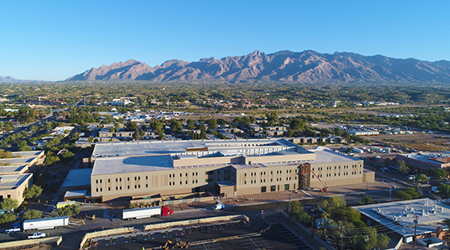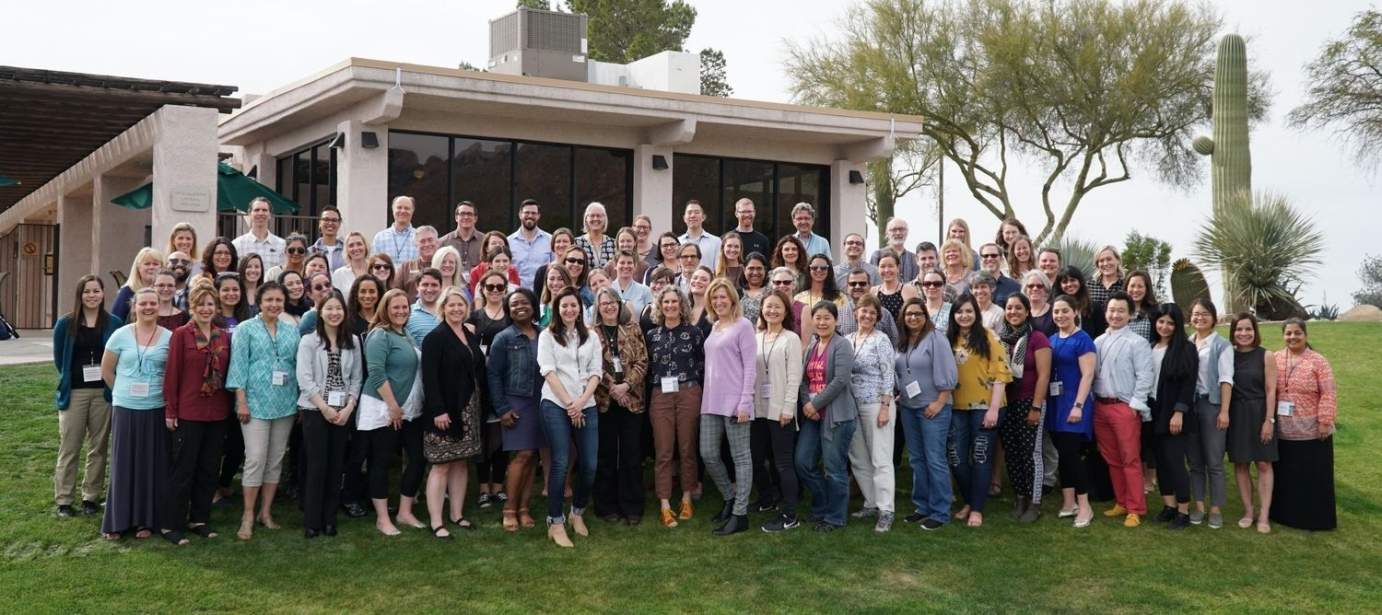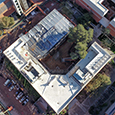 Within the UA Department of Medicine, there are more than 250 faculty physicians on staff spread across 12 divisions representing all subspecialties in internal medicine and related research.
Within the UA Department of Medicine, there are more than 250 faculty physicians on staff spread across 12 divisions representing all subspecialties in internal medicine and related research.
We participate in the education of about 500 medical students at the UA College of Medicine – Tucson, offering clerkship and sub-internship opportunities for third- and fourth-years with an interest in internal medicine and rotation electives in all of our subspecialties.
 In addition to the many medical students we teach, our faculty physicians train more than 130 resident physicians in our ACGME-accredited Internal Medicine Residency Program (the Tucson and South Campus programs merged in 2022-23) and our Advanced Dermatology Residency Program.
In addition to the many medical students we teach, our faculty physicians train more than 130 resident physicians in our ACGME-accredited Internal Medicine Residency Program (the Tucson and South Campus programs merged in 2022-23) and our Advanced Dermatology Residency Program.
We also train about 80 fellows in various subspecialties in our 17 fellowship programs accredited by the Accreditation Council for Graduate Medical Education (ACGME).
 In addition, graduates of our Fellowship in Integrative Medicine, through the UA Andrew Weil Center for Integrative Medicine which serves as the Division of Integrative Medicine within the Department, are eligible for board certification from the American Board of Integrative Medicine (ABOIM). The Center also hosts an Integrative Medicine in Residency Program that's designed around ACGME and ABOIM standards.
In addition, graduates of our Fellowship in Integrative Medicine, through the UA Andrew Weil Center for Integrative Medicine which serves as the Division of Integrative Medicine within the Department, are eligible for board certification from the American Board of Integrative Medicine (ABOIM). The Center also hosts an Integrative Medicine in Residency Program that's designed around ACGME and ABOIM standards.
And we are affiliated with multiple centers of excellence under the UArizona College of Medicine – Tucson and UArizona Health Sciences.
Research Resources
 You can visit our Centers & Institutes webpage to learn more about related research opportunities. They include more than a dozen major health care focus areas, among them the UA Center on Aging, Arthritis Center, Asthma and Airway Disease Research Center, Cancer Center, Liver Institute, Sarver Heart Center and Valley Fever Center for Excellence.
You can visit our Centers & Institutes webpage to learn more about related research opportunities. They include more than a dozen major health care focus areas, among them the UA Center on Aging, Arthritis Center, Asthma and Airway Disease Research Center, Cancer Center, Liver Institute, Sarver Heart Center and Valley Fever Center for Excellence.
We also are affiliated with the UArizona BIO5 Institute (on left, below right), with recently completed adjacent research and simulation lab facilities involving capital improvements of nore than a quarter of a billion dollars. 
These include the new Health Sciences Innovation Building (HSIB) and Biosciences Research Laboratory (BSRL)—on right at right.  It also includes the new UArizona Center for Drug Discovery at the UA College of Pharmacy (at left).
It also includes the new UArizona Center for Drug Discovery at the UA College of Pharmacy (at left).
For the latest UArizona Health Sciences campus construction see Project Updates at this link. For additional updates, background, videos and photos of all UArizona Planning, Design and Construction projects, click here.
Clinical Resources
Our primary clinical teaching facilities, including the new Banner – University Medicine North comprehensive outpatient center (above right), are:
- Banner – University Medical Center Tucson.
 This hospital (on left at right) first opened on the University of Arizona campus in 1971 as University Hospital and later became University Medical Center (UMC), then the University of Arizona Health Network (UAHN) after UMC's merger with University Physicians Healthcare (UPH) in 2010. With approval of the Arizona Board of Regents, UAHN merged with Banner Health in 2015, and the hospital joined its new Banner University Medicine academic division. Now, the hospital has completed a $446-million expansion that includes adding a new state-of-the-art, nine-story hospital tower to its campus that opened in April 2019. See additional detail below...
This hospital (on left at right) first opened on the University of Arizona campus in 1971 as University Hospital and later became University Medical Center (UMC), then the University of Arizona Health Network (UAHN) after UMC's merger with University Physicians Healthcare (UPH) in 2010. With approval of the Arizona Board of Regents, UAHN merged with Banner Health in 2015, and the hospital joined its new Banner University Medicine academic division. Now, the hospital has completed a $446-million expansion that includes adding a new state-of-the-art, nine-story hospital tower to its campus that opened in April 2019. See additional detail below...
FACTS & FIGURES ►►► - Banner – University Medical Center South. Banner – UMC South (on right, above right) began originally as a hospital built by Pima County near 38th Street and Sixth Avenue in 1935 using funds from President Franklin D. Roosevelt’s New Deal. The current building went up in 1977, when the county built Kino Community Hospital on Ajo Way, and came under its current management structure after UPH - which took over management of the hospital in 2005 - merged with UMC to form UAHN in 2010. It was most recently expanded with the addition of a new Emergency Room and Behavioral Health Pavilion in August 2011. Also included on the southside campus are outpatient facilities in the Pima County-built Abram’s Public Health Center (which opened in December 2012) that include Banner – UMC Family & Community Medicine and Diabetes clinics, and Banner's Diabetes Prevention & Education Center. See additional detail below...
FACTS & FIGURES ►►► - Banner – University Medicine North.
 This 208,000-square-foot, three-story outpatient services center on 13 acres that include the new Building 2 opened in December 2017, nestled between the University of Arizona Cancer Center – North Campus clinic and the Ronald McDonald House of Southern Arizona on Allen Road east of Campbell Avenue. Patient care for the more than 25 specialties represented range from cardiology to neurosurgery to rheumatology—with a joint kidney stones clinic by urology/nephrology/nutritional science clinicians the latest to be launched (July 2018).
This 208,000-square-foot, three-story outpatient services center on 13 acres that include the new Building 2 opened in December 2017, nestled between the University of Arizona Cancer Center – North Campus clinic and the Ronald McDonald House of Southern Arizona on Allen Road east of Campbell Avenue. Patient care for the more than 25 specialties represented range from cardiology to neurosurgery to rheumatology—with a joint kidney stones clinic by urology/nephrology/nutritional science clinicians the latest to be launched (July 2018).
FACTS & FIGURES ►►►  University of Arizona Cancer Center – North Campus. This 82,000-square-foot clinic, also known as the Peter and Paula Fasseas Cancer Clinic, opened in 2007 on the site of the old Tucson Hospital. It includes multiple outpatient services related to hematology and oncology patient needs ranging from dermatological issues to infusion therapy to outpatient surgery.
University of Arizona Cancer Center – North Campus. This 82,000-square-foot clinic, also known as the Peter and Paula Fasseas Cancer Clinic, opened in 2007 on the site of the old Tucson Hospital. It includes multiple outpatient services related to hematology and oncology patient needs ranging from dermatological issues to infusion therapy to outpatient surgery.
FACTS & FIGURES ►►►
Multiple other Baner – UMC outpatient facilities exist across Tucson and in Green Valley and Sierra Vista, Ariz.
Search all Banner – University Medicine locations & services
Banner – University Medical Center Tucson
With 649 licensed beds, this hospital is the only Level I Trauma Center designated in Southern Arizona.
It has been ranked nationally by U.S. News & World Report in gynecology, nephrology, and pulmonology and lung surgery (two of which are in the UA Department of Medicine), and previously recognized as high performing in four subspecialties (cancer care, diabetes and endocrinology, gastroenterology and GI surgery, and geriatrics—all in the Department of Medicine) and two adult procedures (colon cancer surgery and heart failure—again, in the Department of Medicine). U.S. News also recognized the hospital as the No. 1 facility in Tucson and Southeastern Arizona, and No. 3 in the state, just behind its sister facility Banner – UMC Phoenix.
The hospital also is accredited as:
- A Primary Stroke Center by The Joint Commission;
- Chest Pain Center by the Society of Cardiovascular Patient Care;
- Non-Invasive Vascular Lab by the Intersocietal Accreditation Commission (IAC);
- Comprehensive Cancer Center by the National Cancer Institute;
- An NPF Referral Center by the National Pancreas Foundation;
- A Scleroderma Foundation recognized Research and Treatment Center;
- A World Association of Sarcoidosis and Other Granulomatous Disorders (WASOG) recognized Sarcoidosis Clinic; and
- A Magnet® hospital by the American Nurses’ Credentialing Association
Its Interstitial Lung Disease Program, operated with the UA Division of Pulmonary, Allergy, Critical Care and Sleep Medicine, also was chosen as a member of the National Pulmonary Fibrosis Foundation’s Care Center Network.
Its Transplantation Services Program is recognized as an Aetna "Institutes of Excellence™ Transplant Facility" for kidney, lung, pancreas and bone marrow transplants.
Its Petersen Clinics, operated with the UA Division of Infectious Diseases, are recognized by the University HealthSystem Consortium as rating No. 3 in the nation for HIV patient care.
Through the UA Center on Aging, it's recognized as a Home-Centered Care Institute "center of excellence."
And it is designated as one of 55 Ebola Treatment Centers in the nation by the U.S. Centers for Disease Control and Prevention.
Becker’s Hospital Review also named Banner – UMC Tucson one of the “100 Great Hospitals in America.”
Banner – University Medical Center South
With 245 licensed beds, this hospital in south Tucson is recognized as:
- An IBM Watson Health 100 Top Hospital;
- An accredited Cardiac Receiving Center by the Arizona Department of Health Services (ADHS);
- Non-Invasive Vascular Lab by the IAC;
- A Certified Diabetes Self-Management Education Program by the American Diabetes Association;
- An Infectious Disease Treatment Center of Excellence by the ADHS,
- A Senior Friendly Hospital by the Nurses Improving Care for Healthsystem Elders (NICHE) Program, and
- A state-designated Trauma Center.
For a full list of accreditations, certifications and more for the above and other clinical facilities where we practice, see:

